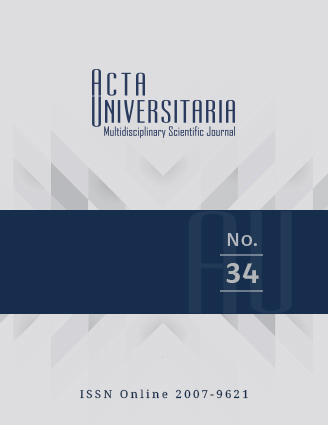Artículos de Investigación
Stable isotopes (D, 18O) of local meteoric water lines and their relationship with thermal-groundwater in the Cuenca Alta del Río Laja basin, Guanajuato, Mexico
Published 2024-10-16
How to Cite
Ramírez-González, L. M., Puy-Aquiza, M. J. ., & Li, Y. . (2024). Stable isotopes (D, 18O) of local meteoric water lines and their relationship with thermal-groundwater in the Cuenca Alta del Río Laja basin, Guanajuato, Mexico. Acta Universitaria, 34, 1–8. https://doi.org/10.15174/au.2024.4156
Abstract
The isotopic composition (d18O and dD) of precipitation was analyzed in three stations in the central part of the Cuenca Alta del Río Laja basin during the years 2022 and 2023. Local precipitation follows the regressions: precipitation 2022 dD = 7.349 d18O + 0.693 and precipitation 2023 dD = 4.72 d18O – 7.175. The 2022 local meteoric water line is congruent with the global, the Mexican, and the basin of Mexico meteoric water lines. The 2023 local meteoric water line shows the El Niño signature with more positive delta values. The isotopic compositions of the thermal-groundwater suggest a meteoric origin without a significant d18O enrichment.
References
- Araguás-Araguás, L., Froehlich, K., & Rozanski, K. (2000). Deuterium and oxygen-18 isotope composition of precipitation and atmospheric moisture. Hydrological Processes, 14(8), 1341-1355. https://doi.org/10.1002/1099-1085(20000615)14:8<1341::AID-HYP983>3.0.CO;2-Z
- Craig, H. (1961). Isotopic variations in meteoric waters. Science, 133(3465), 1702-1703. https://doi.org/10.1126/science.133.3465.1702
- Cortés, A., Durazo, J., & Farvolden, R. N. (1997). Studies of isotopic hydrology of the basin of Mexico and vicinity: annotated bibliography and interpretation. Journal of Hydrology, 198(1-4), 346-376. https://doi.org/10.1016/S0022-1694(96)03273-8
- Diamond, R. E. (2022). Stable isotope hydrology. The Groundwater Project. https://doi.org/10.21083/978-1-77470-043-3
- Drever, I. J. (1997). The Geochemistry of Natural Waters, Surface and Groundwater Environments.
- Gerardo-Abaya, J., D’Amore, F., & Arnórsson, S. (2000). Isotopes for geothermal investigations. En S. Arnórsson (ed.), Isotopic and chemical techniques in geothermal exploration development and use: sampling methods, data handling, interpretation (pp. 49-65). International Atomic Energy Agency.
- Instituto Nacional de Estadística y Geografía (INEGI). (1998). Estudio hidrológico del Estado de Guanajuato. https://www.inegi.org.mx/app/biblioteca/ficha.html?upc=702825222253
- Instituto Nacional de Estadística y Geografía (INEGI). (2021). Continuo de Elevaciones Mexicano. https://www.inegi.org.mx/app/geo2/elevacionesmex/
- Servicio Meteorológico Nacional (SMN). (2023a). Normales climatológica por Estado: Guanajuato. https://smn.conagua.gob.mx/es/informacion-climatologica-por-estado?estado=gto
- Servicio Meteorológico Nacional (SMN). (2023b). Aviso de Ciclón Tropical en el Océano Pacífico. No. Aviso: 23. https://smn.conagua.gob.mx/es/?option=com_visforms&view=visformsdata&layout=data&id=107&cid=5715
- Wassenaar, L. I., Van Wilgenburg, S. L., Larson, K., & Hobson, K. A. (2009). A groundwater isoscape (D, 18O) for Mexico. Journal of Geochemical Exploration, 102(3), 123-136. https://doi.org/10.1016/j.gexplo.2009.01.001
- World Meteorological Organization (WMO). (2023). World Meteorological Organization declares onset of El Niño conditions [Comunicado de prensa]. https://wmo.int/es/node/21584

